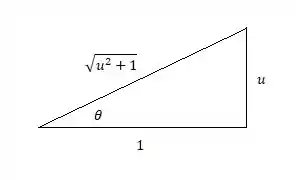Calcule a integral indefinida:
Passo 1
Primeiro vamos fazer uma substituição para a integral ficar no formato para aplicar uma substituição trigonométrica:
Substituindo temos:
Passo 2
Para resolver essa integral vamos fazer uma substituição trigonométrica, temos que a expressão é da forma , nesse formato de expressão vamos fazer e utilizar a identidade trigonométrica :
Substituindo temos:
Agora usando a identidade trigonométrica:
Passo 3
Para calcular essa primeira integral vamos usar substituição, na primeira vamos ter:
Aplicando vamos ter:
Agora é fácil achar as primitivas da função, usando uma expressão da Tabela de Integrais Indefinidas:
Aplicando:
Passo 4
Na segunda vamos usar uma expressão da Tabela de Integrais Indefinidas:
Agora é só aplicar:
Vamos juntar tudo:
Passo 5
Calma, não terminou ainda, vamos ter que voltar para a variável original :
Temos que , assim vamos usar o triângulo retângulo abaixo:

Assim os valores de e são:
Pronto, ficamos então com: